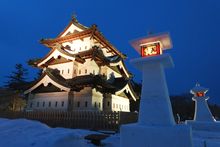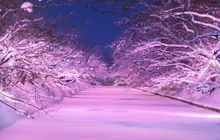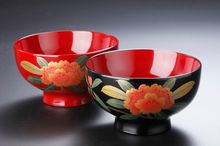 19 Dec 2023
19 Dec 2023
Tags: Tohoku, tohokujapan, Japan, tohokutourism, aomori, hirosakicity, lanternfestival, snowlanternfestival, neputa, akita, yokotecity, japanfestival, fukushima, aizuerosoku, paintedcandle, tsurugajo

In the midst of a freezing and harsh cold, snow falls silently and builds up on the ground. When one thinks of winter in Tohoku, such poetic scenery comes to mind. In reality, although there may be variations in snowfall levels, snow is a part of winter in the Tohoku region. That is why festivals related to snow, the bounty of winter, are held in this region.
The snow that has accumulated in various places adorns the festivals in different forms. It can be made into lanterns or small rooms with lights inside, or used to create snow caves to worship the gods, or even hold festivals in the midst of vast snowy landscapes. Each of these is adorned with a fantastic beauty created by the natural artistry of snow.
Moreover, the winter festivals in Tohoku have flourished thanks to the dedication of the local community. Residents, committed to upholding the region's culture and traditions, have collaborated to craft delightful experiences amid the chilly winters of the northern region. This collective effort stands as a distinctive feature of these festivals.
The winter festivals of Tohoku, breathtakingly beautiful and passed down through generations by the local community, are bound to move the visitors, to the point where they forget the cold.
Experience the Magical Atmosphere of the Hirosaki Castle Snow Lantern Festival
Hirosaki Castle, the symbol of Hirosaki City in Aomori Prefecture, has supported the city's development. The site has been developed into Hirosaki Park and is open to the public as a place of relaxation for the residents. Within the park is a three-story castle tower completed in 1810. Visitors can have a close-up view and even explore the interior (closed during winter from November 24 to March 31). The remaining castle tower from the Edo period is a valuable structure that can only be seen here in Tohoku. (Currently, the main keep's stone wall is undergoing its first repair in 100 years, and the castle tower is accessible to the public on a temporary platform within the main enclosure. It is expected to return to its original position in 2026 at the earliest)
Every February, Hirosaki Park hosts the Hirosaki Castle Snow Lantern Festival, drawing a large crowd. As the name suggests, during the festival period, approximately 150 snow lanterns and snow sculptures, along with around 300 miniature igloos, are set up throughout the park. The snow lanterns and snow sculptures that serve as the main decorations for the festival are handmade by the residents. It shows the spirit and ingenuity of the residents enjoying the long, cold, snowy winter.
In addition, the Tsugaru Nishiki-e Grand Corridor is introduced at the venue, adorned with magnificent and splendid paintings of the grand Hirosaki Neputa. Inside the corridor, you can enjoy the atmosphere of the Hirosaki Neputa Festival held every summer, accompanied by the resonating notes of music. The large snow sculptures shaped like historical buildings and giant slides contribute to enlivening the venue.
The festival is held from daytime, but we recommend visiting from dusk into the night. The snow-covered castle tower is beautifully illuminated, with lights and candles shining snow lanterns and miniature igloos, creating an elegant display of Neputa paintings that come to life on winter nights. The large snow sculpture is embellished with projection mapping, creating a more dazzling spectacle. The main keep area with a castle tower has an ethereal atmosphere, the miniature igloos illuminated by candlelight are enchanting, and the projection mapping adds vibrancy, allowing visitors to enjoy various atmospheres through the combination of snow and light.
After enjoying the illuminated Hirosaki Castle Snow Lantern Festival, take a stroll around Hirosaki City surrounding the venue. During the festival period, various locations are lit up throughout the city under the theme of Hirosaki Electrical Fantasy.
The first thing to see is the Illuminated Winter Cherry Blossoms held at the outer moat near Otemon Gate in Hirosaki Park. Hirosaki Park, with approximately 2,600 cherry trees, is famous as a cherry blossom viewing spot that attracts many visitors from Japan and abroad in spring. During the winter season, of course, cherry blossoms do not bloom. However, during the event period, the snow that beautifully accumulates on the branches is illuminated, allowing you to enjoy a fantastical sight that resembles fully bloomed cherry blossoms.
There are also numerous Western-style buildings scattered throughout the city, such as the Former Hirosaki City Library and the Western-style building at Fujita Memorial Garden. In addition, various parts of the city are lit up, such as the front yard of Hirosaki City Hall and Otemon Square, making the townscape particularly beautiful.
Also, for those who wish to further experience the Hirosaki Neputa that they saw at the Hirosaki Castle Snow Lantern Festival, it's recommended to visit the tourist facility Tsugaru-han Neputa Village, located not far from Hirosaki Park. Visitors will be greeted by life-sized Neputa floats, reminiscent of the Hirosaki Neputa Festival in summer, and experience live Hayashi performances accompanied by flutes and drums. You can also observe the production of folk crafts unique to the area and live performances of the Tsugaru Shamisen ( ). Not only can you experience the Neputa Festival, but you can also immerse yourself in various cultures that have been nurtured in Hirosaki.
The Igloos at Yokote Kamakura Festival are Beautiful to Look at and Relaxing Once Inside
Building small houses by piling up snow and digging holes, known locally as Kamakura (igloo), is a winter activity that anyone living in snowy regions has likely tried at least once. Yokote City in Akita Prefecture, known as one of Japan's snowiest regions, has seen the fusion of two traditional activities over the years: the building of igloos by children and the celebration of the water deity during Koshogatsu (little New Year). This fusion has evolved into the current festival known as Yokote Kamakura Festival. The festival is said to have a history of about 450 years and has become a nationally known winter festival in Tohoku.
On the night of February 15 and 16 every year, when the Yokote Kamakura Festival is held, about 60 igloos are created throughout the city, illuminated with warm lights inside. The sight of lights illuminating the igloos that magically appear in the evening townscape is incredibly beautiful and enchanting. There are igloos where children inside serve Amazake ( ) and mochi, so be sure to step inside. The inside of the igloo is quiet and warm, creating an atmosphere that rejuvenates the soul. Don't forget to pray and pay your respects to the water god enshrined at the altar in the back.
In addition, along the Yokote River that flows through the city, approximately 3,500 miniature igloos are built on Janosaki River Beach, and each one is lit with candlelight. The beauty of these small igloos, shining with the light of candles, is as if the Milky Way in the sky has descended to the ground! Change your perspective by viewing the igloos from the Janosaki Bridge or get up close by visiting the riverbank and enjoy a stroll under the starlight. It is possible to tour the igloos and miniature igloos, scattered throughout the city, by walking or taking a free shuttle bus that circulates around the city, including in front of the Yokote City Hall Main Building or Yokote Park.
The Koshogatsu event in Yokote City features a Bonden offering that's held every year on February 16 and 17, at the same time as the Yokote Kamakura Festival. Bonden refers to a large decorative Gohei (wooden wand) called Yorishiro used as a marker or vessel for the descent of divine spirits. The Bonden in Yokote is characterized by its unparalleled size and extravagance.
On February 16th, the Bonden Contest will be held, where each organization competes to showcase the excellence of their elaborately designed Bonden offering. The Asahiokayama Shrine Bonden Dedication will be held on the 17th. A group of lively young men carry Bonden offerings to dedicate to the shrine as they parade through the city, offering prayers for the safety of the city, prosperity in business, and abundant harvests. The sight of hundreds of young people dressed in matching blowing conch shells and chanting "Joyasa, Joyasa" as they advance is truly impressive! You can feel the contrast between the stillness of the igloos and the liveliness of the festival. The Kamakura Festival and the Bonden Dedication in Yokote City are collectively known as the Yokote Snow Festival. By observing both of these two Koshogatsu events, which take place over three days, visitors will experience the culture and customs that have been nurtured in this region.
On February 15 and 16, when Yokote Kamakura Festival will be held, there will be an exhibition of local products called Hokkori Yokocho, where visitors can enjoy Yokote's food culture. Food stalls will line the venue, selling Yokote's specialty, Yokote yakisoba, and other items. Yokote yakisoba, known throughout Japan as a local delicacy, is characterized by stir-frying thick, straight yakisoba noodles, ground pork, and cabbage with sauce and served with sunny-side-up eggs and Fukujinzuke pickles. There are many restaurants in the city that offer this dish, so it's recommended to try the flavors from various establishments.
Candle-lit Snow Scenery at the Aizu Erosoku (Painted Candle) Festival –Yuki Hotaru–
Aizu Erosoku (painted candles) are a traditional craft handed down in the Aizu Region of Fukushima Prefecture. They have a long history, dating back to the mid-Muromachi period. Due to the support from the feudal lord at that time, the cultivation of lacquer trees resulted in the production of lacquerware from the sap and candles from the fruit. In the Azuchi-Momoyama period, candles began to be decorated with pictures of flowers, and by the Edo period, they were known throughout Japan as the finest candles. Even today, there are several candle stores in Aizuwakamatsu City, where craftsmen still make candles by hand, one by one, using traditional methods from wick-making to painting.
The painted candles are colorfully decorated with seasonal flowers such as chrysanthemums, peonies, and wisteria. In addition to the vibrant design, the candles have a thick wick, which results in a larger flame and longer burning time. The Aizu Erosoku Festival was started in the year 2000 with the hope that many people would see these beautiful painted candles and their soft, warm light.
Since then, the festival has been held every year on the second Saturday of February and the day before, and is centered around Tsurugajo Castle Park and Oyakuen Garden, the symbols of Aizuwakamatsu City. The highlight of the Tsurugajo Castle Park venue is the collaboration between the castle and traditional Aizu crafts. As the five-story keep with red tiles shining against the white walls is illuminated, the traditional craftwork of Aizu Hongo ware ceramic lanterns and Aizu lacquering candlesticks are used to light the Aizu painted candles. At Oyakuen Garden, maintained by generations of Aizu lords, bamboo tubes lit by candlelight surround the Shinji-No-Ike Pond, creating an ethereal and magical world. During this season, the venue is transformed into a snow-covered landscape, offering a different appeal from other seasons. The breathtaking scenery where the warm candlelight illuminates the silvery white world is truly a sight to behold.
In addition, elaborate painted candles will be lit at various locations in the city, including Aizu-Wakamatsu Station (JR), , Nanokamachi Street, Noguchi Hideyo Seishun Street, Omachi Street, and Inishie Yumekaido Street. The number of candles lit during the festival is approximately 10,000! Visitors can enjoy the "Aizu illusion" floating on the snowy landscape lit by candlelight, in various places.
The Aizu Region offers numerous traditional crafts besides painted candles. Modern artisans and designers are creating products that cater to today's lifestyle with a fresh perspective while still preserving their respective traditions.
For instance, Aizu lacquer ware has been crafted concurrently with painted candles, utilizing sap extracted from the lacquer tree. A single lacquer ware is created through the craftsmanship of individual artisans who are responsible for each process, from the construction of a sturdy base to the glossy finish and elegant inlay work. Traditional Japanese tableware such as bowls, lacquered boxes, and snack bowls have been beloved for centuries, but in modern times, there are also modern and simple dishes, vases, and small containers that are easy to incorporate into everyday life.
Also, Aizu Hongo ware ceramics, used for ceramic lanterns in the Aizu Erosoku Festival, is one of the traditional crafts handed down in the Aizu region. With a history of approximately 430 years, this is the oldest kiln in the Tohoku Region, possessing a unique characteristic of producing both pottery and porcelain. At present, 12 kiln factories are producing ceramics by incorporating tradition, history, and modernity. You can obtain distinctive pieces with diverse styles and directions, each influenced by the individual characteristics of the kiln.
Take Measures to Protect Yourself From the Cold & Snow-Covered Paths to Enjoy Festivals During the Frigid Winter
When you witness the overwhelmingly beautiful winter festivals in Tohoku, you can't help but forget about the cold. But even so, some people may still feel the cold of a Tohoku winter. If you are interested in attending a festival, we highly recommend that you take proper measures to keep warm, such as wearing winter clothing, thick socks, and boots.
The ground is often covered with snow, and those not accustomed to walking on snow-covered paths may find it slippery. When walking on snow-covered paths, it is best to take small strides and keep the entire sole of the foot on the ground. Shoes with soft soles and deep grooves are more slip resistant.




















